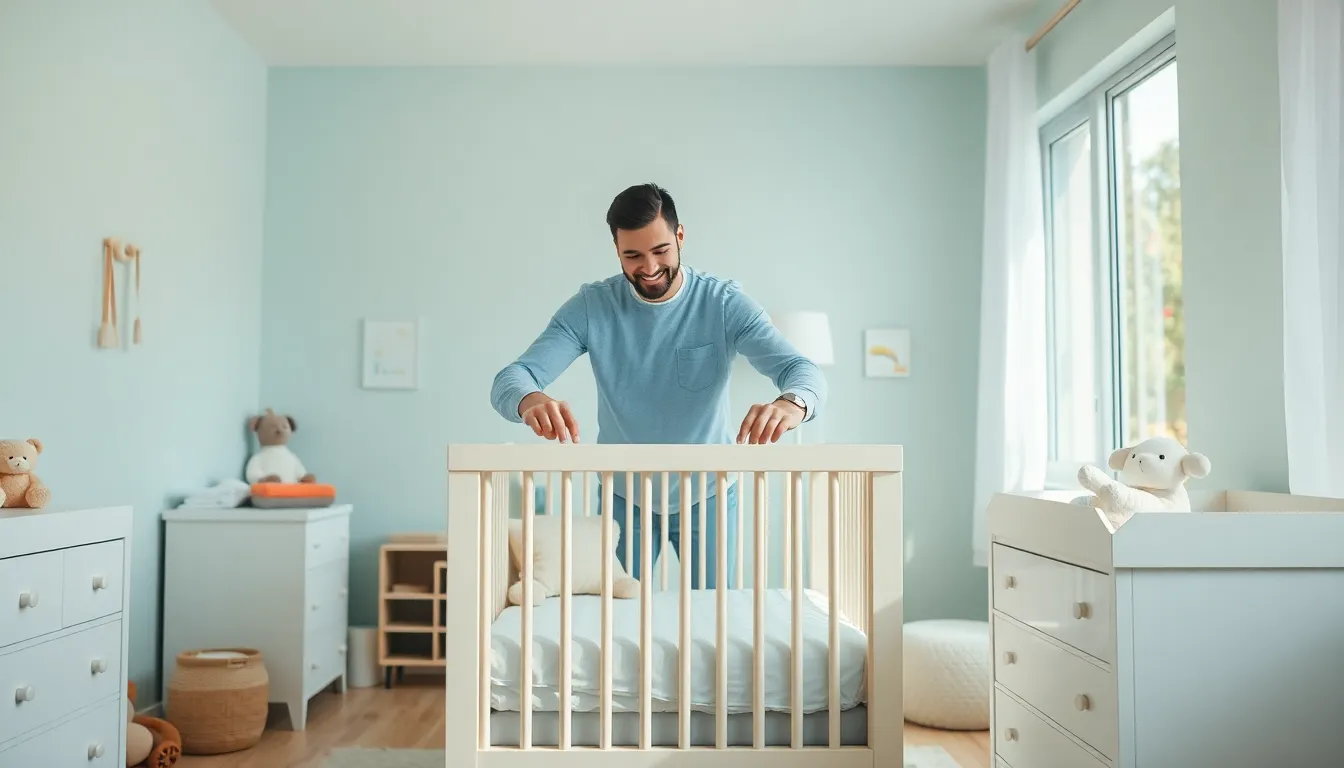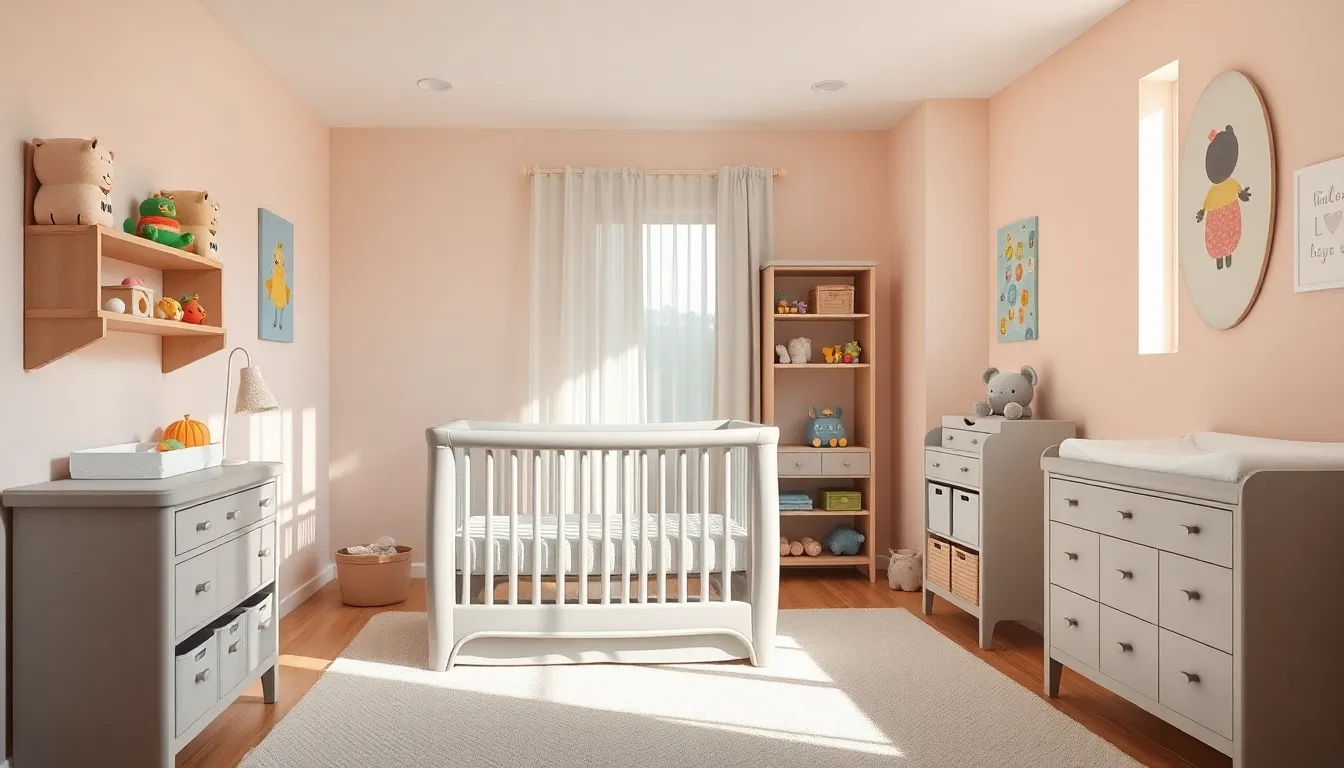Transforming a room into a nursery can feel like preparing for a tiny tornado. With all the excitement of welcoming a new baby, it’s easy to overlook the essentials. From choosing the right crib to organizing those endless baby clothes, setting up a nursery is more than just a Pinterest board come to life. It’s about creating a cozy haven for both baby and parents.
Table of Contents
ToggleNursery Setup Tips for New Parents
Selecting the right crib tops the list of nursery essentials. Safety features like sturdy construction and non-toxic materials should guide the choice. Consider opting for a convertible crib that transitions into a toddler bed, extending its use.
Arranging furniture efficiently enhances functionality. Place the crib near the changing table for convenience. Ensure there’s enough space for movement around the room, allowing quick access to necessities.
Choosing a color scheme can impact the atmosphere. Soft, neutral tones create a calming environment. Accents in brighter hues provide visual interest without overwhelming the space.
Storage solutions are vital for organization. Utilize baskets and bins to store baby clothes, toys, and blankets. Over time, a well-organized nursery reduces stress during busy days.
Lighting plays a significant role in setting the mood. A nightlight offers gentle illumination during nighttime feedings. Adjustable window coverings allow parents to control natural light, promoting better sleep.
Personal touches make a nursery feel special. Incorporating family photos and meaningful decorations adds warmth. Customizing the space with personal items fosters a sense of belonging.
Safety measures are crucial for peace of mind. Anchor heavy furniture to the wall to prevent tipping. Keep small items and choking hazards out of reach to ensure the environment is secure.
Creating a comfortable feeding area benefits both baby and parent. Include a comfortable chair with good back support. A side table or shelf nearby provides easy access to essentials like burp cloths and water.
Planning for growth is essential. Anticipate future needs by considering space for toys and a play area. A versatile design facilitates adjustments as the child grows, making the nursery functional for years.
Choosing the Right Space

Creating a welcoming nursery requires careful consideration of the space itself. Parents must evaluate factors such as location, size, and layout to ensure comfort and functionality.
Location Considerations
Choosing the right location for a nursery involves prioritizing safety and accessibility. Placing the nursery close to the parents’ bedroom enables easy nighttime access. Avoid rooms near noisy areas or high-traffic spaces to minimize disturbances. Natural light enhances mood and can aid in the baby’s development, so look for spaces with good windows. Additionally, ensure the area has easy access to essential items like diapers and feeding supplies.
Size and Layout
In terms of size, a nursery doesn’t need to be large but should accommodate key furniture pieces with enough room for movement. An efficient layout promotes functionality, allowing parents to comfortably access the crib, changing table, and storage. When arranging furniture, prioritize the crib’s placement for easy visibility and approachability. A space plan that includes areas for play and changing stations optimizes utility and encourages interaction.
Essential Nursery Furniture
Choosing the right furniture is key to creating a functional nursery. Essential pieces include a crib and changing table that enhance safety and accessibility.
Crib Selection
Cribs come in various styles and features. A convertible crib adapts as the child grows, making it a versatile option. Safety standards set by the Consumer Product Safety Commission (CPSC) ensure peace of mind. Look for cribs with adjustable mattress heights to accommodate your baby’s needs. Additional features such as slats and rounded edges contribute to safety and comfort. Selecting a crib that fits the nursery space while allowing for movement proves essential for a practical setup.
Changing Table Options
A changing table serves multiple purposes, making it a vital addition. Models with built-in storage keep diapers, wipes, and clothing organized. Consider a design that can double as a dresser to save space. Height adjustments promote comfort for caregivers during diaper changes. Changing tables with safety straps and railings prevent slips. Prioritizing accessibility ensures easy access to commonly used items, helping streamline daily routines.
Decor and Ambiance
Creating an inviting atmosphere for a nursery enhances a child’s comfort and mood. A well-thought-out decor and ambiance contribute significantly to both aesthetics and functionality.
Color Schemes
Neutral tones like soft grays and pale yellows promote a calming environment. Choosing pastel colors can stimulate a sense of peace. Incorporating brighter accents through toys or wall art adds vibrancy without overwhelming the space. Consider using removable wall decals for easy updates as the child grows. Balance is key; mix light and dark shades to prevent monotony while ensuring a welcoming feel. Custom color palettes can personalize the nursery, reflecting the family’s taste while appealing to the baby’s senses.
Lighting Solutions
Soft, adjustable lighting ensures the nursery remains cozy at all hours. Ceiling fixtures should provide ample illumination for daytime activities. Dimming options create a serene setting for bedtime routines. Additionally, consider using table lamps or floor lamps for targeted light during nighttime feedings. Natural light should also be prioritized through sheer curtains that filter brightness while maintaining privacy. Incorporating night lights can ease anxiety, providing subtle illumination for late-night visits. Overall, a well-lit nursery supports healthy development and fosters a soothing ambiance.
Organizing and Storage Solutions
Effective organization and storage solutions enhance functionality in the nursery, ensuring easy access to baby essentials and keeping the space tidy. Focus on maximizing storage by utilizing every available area.
Closet Organization
Closet organization plays a crucial role in maintaining an orderly nursery. Use bins or baskets to separate items like clothing, blankets, and accessories. Consider hanging organizers for shoes and small items. Assign specific sections for different age groups to streamline the selection process as the baby grows. Labeling shelves or bins aids in quick identification, promoting independence later on. Ensuring that frequently used items are within easy reach makes daily routines smoother for parents.
Toy Storage Ideas
Toy storage ideas contribute significantly to a clutter-free environment. Use open shelving to display toys, encouraging children to engage with their belongings. Bins or baskets can serve to collect toys of similar types, such as plush toys and building blocks. Incorporating furniture with built-in storage, like benches or ottomans, combines functionality with aesthetics. Additionally, wall-mounted storage or hooks keeps toys off the floor, maximizing space. Rotating toys periodically maintains interest while reducing visual clutter in the nursery.
Safety Considerations
Ensuring safety in a nursery is paramount. Implementing proper childproofing measures protects the baby from potential hazards.
Childproofing Essentials
Securing furniture to walls prevents tipping hazards, especially with items like bookshelves. Covering electrical outlets with safety plugs stops curious little fingers from exploring. Utilizing corner guards on sharp furniture edges reduces the risk of injury during play. Installing baby gates helps keep the child contained, particularly in unsecured areas. Keeping small objects out of reach is crucial, as these can pose choking hazards. Regularly checking for loose cords or small items on the floor maintains a safe environment. Baby-proofing creates a secure space that fosters exploration without unnecessary risks.
Choosing Non-Toxic Materials
Selecting non-toxic materials is vital for a healthy nursery environment. Focus on furniture constructed from solid wood rather than particle board, which often contains harmful chemicals. Choosing paint with low or zero VOC (volatile organic compounds) ensures better indoor air quality. Opting for organic fabrics in bedding and curtains reduces exposure to chemicals found in conventional fibers. Furniture finishes should also emphasize non-toxic options to avoid harmful side effects. Prioritizing natural materials creates a safer space where the baby’s well-being remains front and center.
Conclusion
Creating a nursery is an exciting journey filled with important decisions. By focusing on safety functionality and aesthetics parents can craft a space that not only looks beautiful but also serves their child’s needs. Thoughtful organization and clever storage solutions make daily routines smoother while ensuring a clutter-free environment.
As children grow their needs will evolve and planning for this growth ensures the nursery remains practical for years to come. By incorporating personal touches and maintaining a calming atmosphere parents can foster a nurturing environment that supports their child’s development. Ultimately a well-designed nursery lays the foundation for countless cherished moments.








